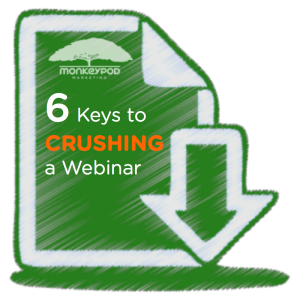Webinars are legit. If done properly, they can be a really powerful way to drive engagement and deliver massive value to your audience.
However, there are certainly some things you need to be aware of when you’re running a webinar. The difference between a killer webinar and a flop can be really subtle. I’ll cover 3 of the 6 keys in this post.
As you probably know, I worked at Infusionsoft for a little over three years. Like most Infusionites, I moved around a little bit during that time, but no matter what position I held I was regularly tapped to either run or contribute to webinars. I picked up a few tips along the way, and if you’re going to run webinars for your business, learning these keys will save you some time and help you avoid a few headaches.
Also, it’s worth mentioning that a lot of what I learned came directly from the original Infusionsoft Mastermind (and recent licensed shark hunter), Jordan Hatch. The man is an archive of all sorts of knowledge, and webinars are certainly something he’s earned his stripes at. In fact the keys in this article, and many of the webinars I’ve delivered over the past three years, were inspired heavily by the information Jordan delivered in a mastermind call from 2012 titled “Everything I know about running webinars”. </shout out>
Key Number 1: Do the Training
 Most webinar platforms have extensive training programs to familiarize you with their interface. Do the tutorials, and learn the system. Check the system specs and make sure that your equipment will work with the platform you’ve chosen. The training is important not only because it’s helpful to have a basic understanding, but also because there are probably some features that will make your attendee’s experience much more enjoyable (drawing, captions, questions, surveys, mouse highlights, etc).
Most webinar platforms have extensive training programs to familiarize you with their interface. Do the tutorials, and learn the system. Check the system specs and make sure that your equipment will work with the platform you’ve chosen. The training is important not only because it’s helpful to have a basic understanding, but also because there are probably some features that will make your attendee’s experience much more enjoyable (drawing, captions, questions, surveys, mouse highlights, etc).
Key Number 3: Go Slowly
 The slower you talk, the more time you have to react. I don’t know about you, but I personally have a tendency to speed up when I get going, and then periodically I’ll stop and do a temperature check and see how everyone is doing. This does not create a positive attendee experience. Don’t make them tell you to slow down, go slowly, and repeat yourself. Also, during live webinars there’s a good chance there may be some lag, especially when there is movement on the screen(video, screencast, etc), and going slowly reduces the risk of leaving people behind.
The slower you talk, the more time you have to react. I don’t know about you, but I personally have a tendency to speed up when I get going, and then periodically I’ll stop and do a temperature check and see how everyone is doing. This does not create a positive attendee experience. Don’t make them tell you to slow down, go slowly, and repeat yourself. Also, during live webinars there’s a good chance there may be some lag, especially when there is movement on the screen(video, screencast, etc), and going slowly reduces the risk of leaving people behind.
Key Number 5: Don’t Try and Do Too Much
 Your webinar can feel hectic and overwhelming if you try and cover too much material. You want your webinar to feel informative, and digestible; not too helter skelter. It’s much better to give them 3 things that your audience can use, than 50 ideas that they cant. People don’t care about information, we care about the results that information creates. Knowing something in a vacuum is much less valuable if we don’t have the capacity to exercise it. Remember, if they love it, you can always do another webinar. But if you cram too much in you’ll dilute the value for the topics you do cover, and you’ll risk pushing people away.
Your webinar can feel hectic and overwhelming if you try and cover too much material. You want your webinar to feel informative, and digestible; not too helter skelter. It’s much better to give them 3 things that your audience can use, than 50 ideas that they cant. People don’t care about information, we care about the results that information creates. Knowing something in a vacuum is much less valuable if we don’t have the capacity to exercise it. Remember, if they love it, you can always do another webinar. But if you cram too much in you’ll dilute the value for the topics you do cover, and you’ll risk pushing people away.
So, that’s half of the keys. If this is the type of jam you like, then you can grab the rest of them here. Enjoy.
of the keys. If this is the type of jam you like, then you can grab the rest of them here. Enjoy.
If you have other tips you’ve learned through running webinars of your own, please feel free to share in the comments below! (I’m talking to you Suzi!)






Great post. In addition to the 6 tips you outline I’d also add that you make sure you study up on the topic you are presenting on. Sometimes you’re doing a webinar on a topic you are not an expert in which is fine, but if doing so make sure to spend extra time practicing and studying the topic so that you have greater confidence during the webinar and especially during the Q&A.
So true. And if you do get a question that you don’t know the answer to, acknowledge that, but then explain the process for finding the answer. Haha, I’m now wondering if this comes from personal experience…have you found yourself in this situation Todd? Presenting on something you hadn’t done homework on?